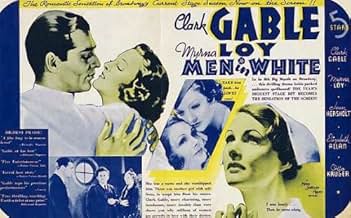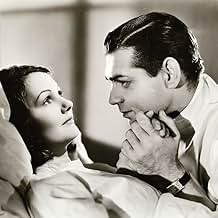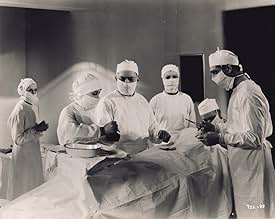Ajouter une intrigue dans votre langueAn idealistic doctor must make some hard choices between his dedication to the profession and his personal life.An idealistic doctor must make some hard choices between his dedication to the profession and his personal life.An idealistic doctor must make some hard choices between his dedication to the profession and his personal life.
- Réalisation
- Scénario
- Casting principal
- Récompenses
- 2 victoires au total
Harry C. Bradley
- Minister
- (non crédité)
Frank Burke
- Interne
- (non crédité)
Ruth Channing
- Nurse
- (non crédité)
Berton Churchill
- John Hudson
- (non crédité)
Avis à la une
I stumbled across this and TIVOed it -- curious to see a young Clarke Gable, with Myrna Loy.
The thing that grabbed me most was the cinematography. The use of shadows was very evocative, almost Citizen Kane-like. Beautifully framed shots, sometimes looking slightly up or down, slightly angled. Very poetic. A few crane shots. Worth seeing for the cinematography alone.
All the early 30s doctors in their white robes look like they exist and work in some idealized, futuristic art deco spaceport. Very odd and interesting to look at.
The other reviewer here pointed out that there was no music. Without the sappy over the top music to help tell the story, we instead experience the evocative camera-work in it's splendor.
Definitely worth a watch.
The thing that grabbed me most was the cinematography. The use of shadows was very evocative, almost Citizen Kane-like. Beautifully framed shots, sometimes looking slightly up or down, slightly angled. Very poetic. A few crane shots. Worth seeing for the cinematography alone.
All the early 30s doctors in their white robes look like they exist and work in some idealized, futuristic art deco spaceport. Very odd and interesting to look at.
The other reviewer here pointed out that there was no music. Without the sappy over the top music to help tell the story, we instead experience the evocative camera-work in it's splendor.
Definitely worth a watch.
CLARK GABLE is a dedicated doctor conflicted by feelings involving the workplace and romance--almost the forerunner of the character ROBERT MITCHUM would play twenty years later (Luke) in NOT AS A STRANGER. The film deals with medicine much the way Stanley Kramer's film did, but it's based on a stage play and the static quality owes something to that and the lack of background music on the soundtrack.
Of course it's all very dated--a giveaway is interns supposedly making $20 a week!! MYRNA LOY is a selfish, wealthy young woman who wishes Gable would give her his undivided attention instead of dedicating himself to work. Gable has to assert himself at the hospital when an older physician overrules his instructions on insulin and puts a patient into shock. Gable's character here is reminiscent of Lucas Marsh in Morton Thompson's best-seller NOT AS A STRANGER as he pulls the syringe from the doctor's hand and takes charge of the procedure.
There are weak moments of comedy relief, mostly from WALLACE FORD, and a maudlin performance from OTTO KRUGER that is painfully overplayed. The dialog too, tends to be preachy about the medical profession.
Self-doubting and lonely, Gable shares some romantic scenes with pretty nurse ELIZABETH ALLAN who confides in him about her own uneasy feelings as a nurse dealing daily with life and death situations. The love scene is handled with such discretion it's hard to determine the plot developments that come swiftly afterwards, but after Allan's tragic death Gable resumes his romance with Loy, who realizes his work will always come first in his life.
Nothing deep here, just a routine medical drama with all of its stage bound ingredients intact. Music is only used once for a restaurant scene where violins are playing a Viennese waltz, which leaves a lot of the drama feeling flat and one-dimensional.
JEAN HERSHOLT has his usual role of an avuncular medical man under whom Gable intends to study abroad, but the focal point is the Gable/Loy/Allan romantic triangle.
Summing up: From any standpoint, a trifle in Gable's career and notable only in that he plays a more sensitive role than usual.
Of course it's all very dated--a giveaway is interns supposedly making $20 a week!! MYRNA LOY is a selfish, wealthy young woman who wishes Gable would give her his undivided attention instead of dedicating himself to work. Gable has to assert himself at the hospital when an older physician overrules his instructions on insulin and puts a patient into shock. Gable's character here is reminiscent of Lucas Marsh in Morton Thompson's best-seller NOT AS A STRANGER as he pulls the syringe from the doctor's hand and takes charge of the procedure.
There are weak moments of comedy relief, mostly from WALLACE FORD, and a maudlin performance from OTTO KRUGER that is painfully overplayed. The dialog too, tends to be preachy about the medical profession.
Self-doubting and lonely, Gable shares some romantic scenes with pretty nurse ELIZABETH ALLAN who confides in him about her own uneasy feelings as a nurse dealing daily with life and death situations. The love scene is handled with such discretion it's hard to determine the plot developments that come swiftly afterwards, but after Allan's tragic death Gable resumes his romance with Loy, who realizes his work will always come first in his life.
Nothing deep here, just a routine medical drama with all of its stage bound ingredients intact. Music is only used once for a restaurant scene where violins are playing a Viennese waltz, which leaves a lot of the drama feeling flat and one-dimensional.
JEAN HERSHOLT has his usual role of an avuncular medical man under whom Gable intends to study abroad, but the focal point is the Gable/Loy/Allan romantic triangle.
Summing up: From any standpoint, a trifle in Gable's career and notable only in that he plays a more sensitive role than usual.
This is one darn good movie. Clark Gable (pre-GWTW) gives a super performance, and Myrna Loy never looked lovelier (and puts in a good performance herself). The story is compelling without being maudlin, and the comic relief doesn't get in the way (as it usually does). Hospital chaos is well depicted, and not everything turns out rosey. We of our era didn't invent "realistic" hospital drama -- we just think we did. Dated? Of course it's dated -- it was made over 60 years ago. However, sixty years from now, they'll be laughing at the stuff we're putting on TV, but they'll still be riveted to "Men in White."
"Men in White" is a 1934 film starring Clark Gable, Myrna Loy, Jean Hersholt, Elizabeth Allan, and Otto Kruger. Gable plays a promising young doctor, George Ferguson, who is planning on studying in Vienna and then returning and working closely with Dr. Hochberg (Hersholt), apparently in scientific research. He's engaged to a society woman, Laura Hudson (Loy) who is already upset about the lack of time she and George have together. She would rather he go into private practice and work regular hours. This becomes a subject of argument, and the situation goes from bad to worse, particularly one night when an angry Laura stops speaking to George.
This film is based on a Pulitzer Prize winning play by Sidney Kingsley, which, in addition to what is shown in the film, also dealt with anti-Semitism. The idea of going to Vienna in 1934, with the Loy character rhapsodizing over it - guess MGM was out of touch with what was happening, or chose to ignore it.
The acting in this film is very good, if by today's standards, a little melodramatic in parts. Otto Kruger has a very sympathetic role in this - later on he always played someone truly nasty.
The real star of the film is the absolutely incredible art deco hospital set that has to be seen - stunning, with a circular staircase, and huge windows that overlook the George Washington Bridge. The photography is marvelous, particularly an operating room scene where we see doctors observing in a top area reflected through a light.
The other things you'll notice, if you've been alive more than a few years, are the nurses' uniforms and caps and the glass straws, items we don't see any longer. And a little girl's parents who would be cast as her great-grandparents today.
The story isn't spelled out for us - in fact, I can tell you my mother, as an adult, could have sat through it and had no idea what happened. Talk about subtle.
Definitely worth seeing, with Gable and Loy an effective team.
This film is based on a Pulitzer Prize winning play by Sidney Kingsley, which, in addition to what is shown in the film, also dealt with anti-Semitism. The idea of going to Vienna in 1934, with the Loy character rhapsodizing over it - guess MGM was out of touch with what was happening, or chose to ignore it.
The acting in this film is very good, if by today's standards, a little melodramatic in parts. Otto Kruger has a very sympathetic role in this - later on he always played someone truly nasty.
The real star of the film is the absolutely incredible art deco hospital set that has to be seen - stunning, with a circular staircase, and huge windows that overlook the George Washington Bridge. The photography is marvelous, particularly an operating room scene where we see doctors observing in a top area reflected through a light.
The other things you'll notice, if you've been alive more than a few years, are the nurses' uniforms and caps and the glass straws, items we don't see any longer. And a little girl's parents who would be cast as her great-grandparents today.
The story isn't spelled out for us - in fact, I can tell you my mother, as an adult, could have sat through it and had no idea what happened. Talk about subtle.
Definitely worth seeing, with Gable and Loy an effective team.
As mentioned in Moe Howard's book MOE HOWARD & THE 3 STOOGES (Citadel Press, 1977), MEN IN BLACK (1934) an early Three Stooges short made at Columbia Pictures was a take off on MEN IN WHITE. "For duty and humanity" is a phrase used numerous times throughout this twenty minute comedy and is a central theme in the Clark Gable film which was released earlier that same year. MEN IN BLACK, which contains another reoccurring phrase (which many Three Stooges fans will remember immediately) "Calling Dr. Howard, Dr. Fine, Dr. Howard", was nominated for the Academy Award in 1934 for best short. An abbreviated version of this short was reenactment in the ABC-TV movie THE THREE STOOGES (1999) which was produced by Mel Gibson, a well know Stooges enthusiast.
Le saviez-vous
- AnecdotesBecause of the suggested illicit romance and the suggested abortion in the movie, it was frequently cut. The Legion of Decency cited the movie as unfit for public exhibition.
- GaffesNear the end of the film, Dr. Ferguson picks up the telephone before the paging operator even finishes saying his name.
- ConnexionsFeatured in Complicated Women (2003)
Meilleurs choix
Connectez-vous pour évaluer et suivre la liste de favoris afin de recevoir des recommandations personnalisées
Détails
Box-office
- Budget
- 213 000 $US (estimé)
- Durée1 heure 14 minutes
- Couleur
- Rapport de forme
- 1.37 : 1
Contribuer à cette page
Suggérer une modification ou ajouter du contenu manquant

Lacune principale
By what name was Men in White (1934) officially released in Canada in English?
Répondre




































